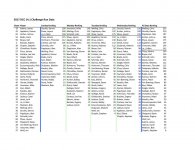Miscellany from the data for the 2017 DCC George Fels Straight Pool Challenge:
[Thanks to Dennis Walsh for giving me a look at the score sheets for the qualifying attempts. This post relates only to the qualifying runs, not the matches in the ensuing tournament.]
• 37 players participated in the event, for a total of 75 entries or buy-ins at $100 each (good for 12 run attempts). Fifteen players bought in just once, 13 players twice, 3 players three times, 5 players (Hunter, Lo, Schmidt, Immonen, and Shaw) four times, and 1 player (Pagulayan) five times.
• With the prize money totaling $22,650 (shown in an earlier post in this thread), the added money was $15,150.
• Several players did not use all 12 of their allowable attempts on a buy-in. [Possible reasons include event conflicts, time issues, fatigue, or satisfaction with what they had already done.] This reduced the total number of attempts by 43, from 900 (12 x 75) to 857.
•
Distribution of the 857 runs:
0 balls pocketed -- 29 times (3.4%)
1-14 -- 321 (37.5%)
15-28 -- 192 (22.4%)
29-49 -- 162 (18.9%)
50-99 -- 116 (13.5%)
100+ -- 37 (4.3%)
So the player failed to get beyond the first rack 41% of the time and didn't get beyond two racks 63% of the time. About 18% of the tries resulted in a run of at least 50.
•
Average runs
Arithmetic mean -- 30.1 balls for the 857 tries
Median -- 18 balls (half the runs lower than or equal to 18, half the runs higher or equal)
The top three players for mean runs were Orcollo at 56.2, Shaw at 46.3, and Boyes at 45.1. Orcollo was also tops for the median at 44, followed by Boyes at 42 and Hohmann at 34.5.
•
100-ball runs -- 17 players accounted for the 37 runs of 100 or more balls. These players made 515 attempts, so their percentage of 100-ball runs was 7.2% (37 of 515).
Orcollo and Archer tied for highest percentage of 100-ball runs. They both had 4 on 24 attempts for 17%. Two of Archer's were on successive attempts, for 216 balls with 1 miss or foul. Three of Orcollo's were on successive attempts, for 424 balls with 2 misses or fouls.
The "almost 100" runs included 4 99's (Chua, Boyes, and Lo Li-Wen twice) and 5 98's (Kiamco, Shaw, Schmidt, and Biado twice -- on successive tries.).
•
Runs of 80 or more -- Runs in the 80's or 90's numbered 33, so the total number of runs of 80 or more was 70. The 21 players who accomplished those runs did so on 582 attempts. So about 12% of those players' tries resulted in runs of 80 or more. The highest was Lo Li-Wen with 10 runs of 80 or more on 42 tries, for 24%. Next best was Shaw -- 9 of 48 for 19%. Ten other players ranged from 10% to 17% on this measure. [This item responds to post #47 in this thread and the mistaken impression that the top guys were running at least 80 one-third of the time.]
•
Unsuccessful break shots -- Failed break shots (defined here simply as ending the run) numbered 29 on the first rack of the 857 run attempts (3.4%, as shown above) and 175 of 1,588 (11.0%) on the 2nd or later rack of a run. So, in total, 8.3% (204 of 2,445) of break shots on new racks were unsuccessful. Far and away the most outstanding performances on this measure were Melling's 2.5% (2 failures on 81 break shots) and Immonen's 2.9% (4 failures on 137 break shots). [Two players had no failures, but the number of racks they faced was quite low.]
•
Runs ended on next shot after successful break shots -- In 158 racks, the player made the break ball but was unable to score any more points after that. This represented 7.1% of the 2,241 successfully broken racks. [Note -- this counts only the runs that ended with 1 point in a new rack. In some cases the player probably made more than one ball on the break shot and the run then ended on the next shot, but the score sheets do not reveal those occasions.]
•
Full-rack clearances -- The players faced 2,445 new, full racks and made full clearances (except for the next break ball) 1,588 times -- 65% successful clearances.

